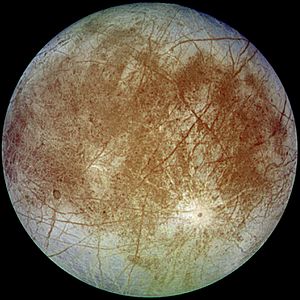Icy moon facts for kids
An icy moon is a natural satellite that has a lot of ice on its surface. These moons are often found far away from the Sun, where it is very cold. Some icy moons might even have huge oceans of liquid water hidden deep under their icy crusts.
In our Solar System, you can find all the known icy moons orbiting the giant planets like Jupiter, Saturn, Uranus, and Neptune. A famous example of an icy moon is Europa, which orbits Jupiter. Scientists are very interested in icy moons because some of them could potentially have conditions suitable for life.
Contents
What is an Icy Moon?
An icy moon is a moon that is mostly made of ice, especially water ice. This ice covers its surface, making it look bright and shiny. Underneath this icy shell, some of these moons might have a rocky core. The amount of ice can be different for each moon. Some are almost entirely ice, while others have a mix of ice and rock.
Where Are Icy Moons Found?
Icy moons are usually found far from the Sun, in the outer parts of our Solar System. This is because it's cold enough there for ice to stay frozen. They orbit the giant gas planets:
- Jupiter: Has several icy moons, including Europa, Ganymede, and Callisto.
- Saturn: Home to icy moons like Enceladus and Titan (which also has a thick atmosphere).
- Uranus and Neptune: Also have icy moons, though they are less explored.
Why Are Icy Moons Important?
Icy moons are very exciting for scientists for a few big reasons:
- Hidden Oceans: Many icy moons, like Europa and Enceladus, are thought to have large oceans of liquid water under their icy surfaces. These oceans are kept warm by the planet's gravity pulling on the moon, which creates heat inside.
- Possibility of Life: Where there is liquid water, there is a chance for life to exist. Scientists are sending spacecraft to these moons to look for signs of life or conditions that could support it.
- Understanding the Solar System: Studying icy moons helps us learn more about how our Solar System formed and changed over billions of years. They can tell us about the early conditions of planets and moons.
Famous Icy Moons
Some icy moons are very well-known because of the amazing things scientists have discovered about them:
- Europa: This moon of Jupiter is one of the most promising places to look for life beyond Earth. It has a smooth, cracked icy surface, and scientists believe a salty ocean lies beneath it.
- Enceladus: Orbiting Saturn, Enceladus is famous for its geysers. These are like icy volcanoes that shoot plumes of water vapor and ice particles into space from cracks near its south pole. This strongly suggests an underground ocean.
- Ganymede: Also a moon of Jupiter, Ganymede is the largest moon in the entire Solar System. It is bigger than the planet Mercury! It has a mix of icy and rocky features and is thought to have a deep subsurface ocean.
See also
 In Spanish: Luna helada para niños
In Spanish: Luna helada para niños


